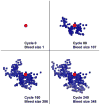Hematoma expansion following acute intracerebral hemorrhage
- PMID: 23466430
- PMCID: PMC3743539
- DOI: 10.1159/000346599
Hematoma expansion following acute intracerebral hemorrhage
Abstract
Intracerebral hemorrhage (ICH), the most devastating form of stroke, has no specific therapy proven to improve outcome by randomized controlled trial. Location and baseline hematoma volume are strong predictors of mortality, but are nonmodifiable by the time of diagnosis. Expansion of the initial hematoma is a further marker of poor prognosis that may be at least partly preventable. Several risk factors for hematoma expansion have been identified, including baseline ICH volume, early presentation after symptom onset, anticoagulation, and the CT angiography spot sign. Although the biological mechanisms of hematoma expansion remain unclear, accumulating evidence supports a model of ongoing secondary bleeding from ruptured adjacent vessels surrounding the initial bleeding site. Several large clinical trials testing therapies aimed at preventing hematoma expansion are in progress, including aggressive blood pressure reduction, treatment with recombinant factor VIIa guided by CT angiography findings, and surgical intervention for superficial hematomas without intraventricular extension. Hematoma expansion is so far the only marker of outcome that is amenable to treatment and thus a potentially important therapeutic target.
Copyright © 2013 S. Karger AG, Basel.
Conflict of interest statement
Figures


References
-
- van Asch CJ, Luitse MJ, Rinkel GJ, van der Tweel I, Algra A, Klijn CJ. Incidence, case fatality, and functional outcome of intracerebral haemorrhage over time, according to age, sex, and ethnic origin: a systematic review and meta-analysis. Lancet Neurol. 2010;9:167–176. - PubMed
-
- Broderick JP, Brott TG, Duldner JE, Tomsick T, Huster G. Volume of intracerebral hemorrhage. A powerful and easy-to-use predictor of 30-day mortality. Stroke. 1993;24:987–993. - PubMed
-
- Flaherty ML, Haverbusch M, Sekar P, Kissela B, Kleindorfer D, Moomaw CJ, et al. Long-term mortality after intracerebral hemorrhage. Neurology. 2006;66:1182–1186. - PubMed
-
- Davis SM, Broderick J, Hennerici M, Brun NC, Diringer MN, Mayer SA, et al. Hematoma growth is a determinant of mortality and poor outcome after intracerebral hemorrhage. Neurology. 2006;66:1175–1181. - PubMed
Publication types
MeSH terms
Grants and funding
LinkOut - more resources
Full Text Sources
Other Literature Sources
Medical

